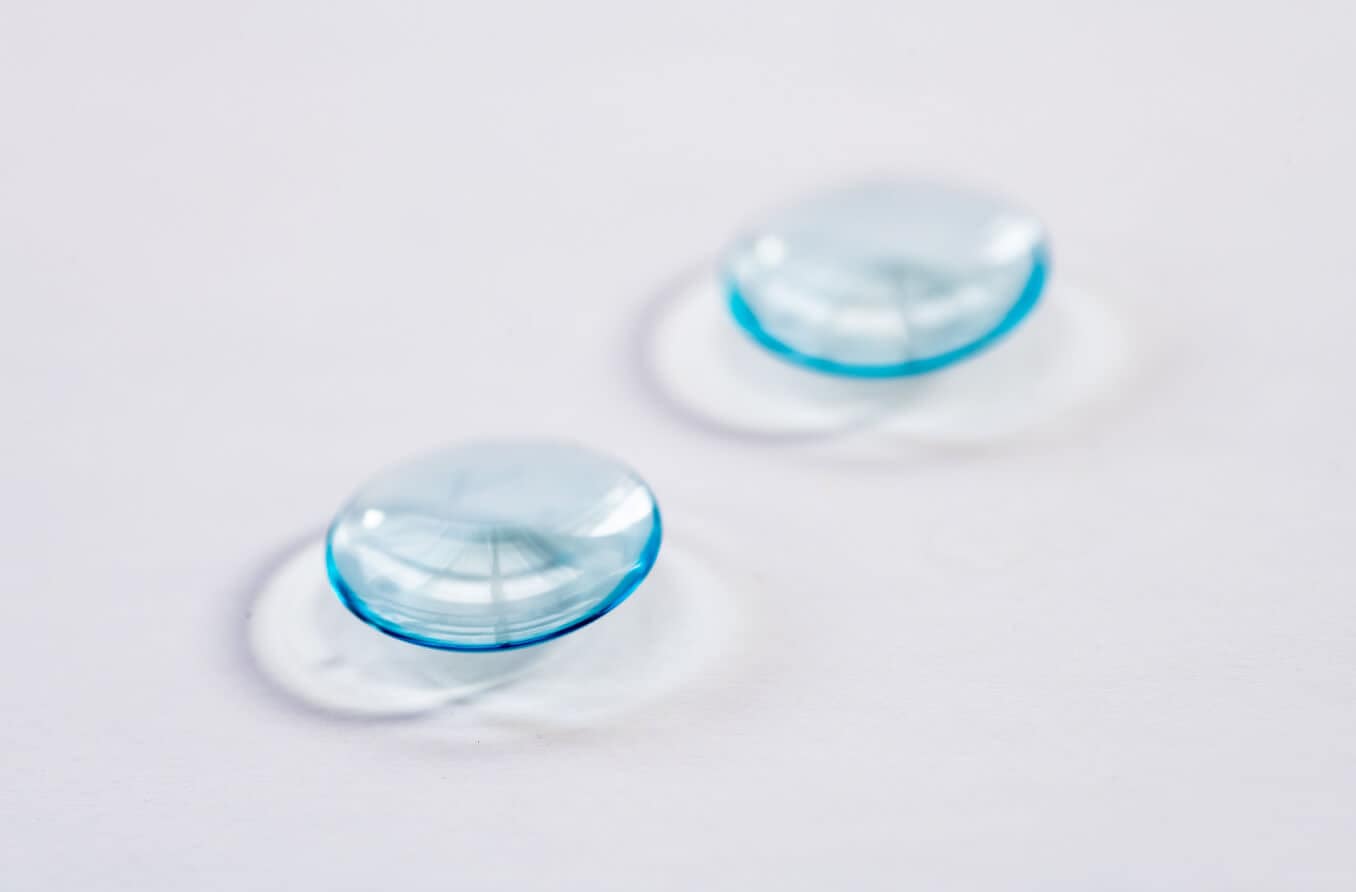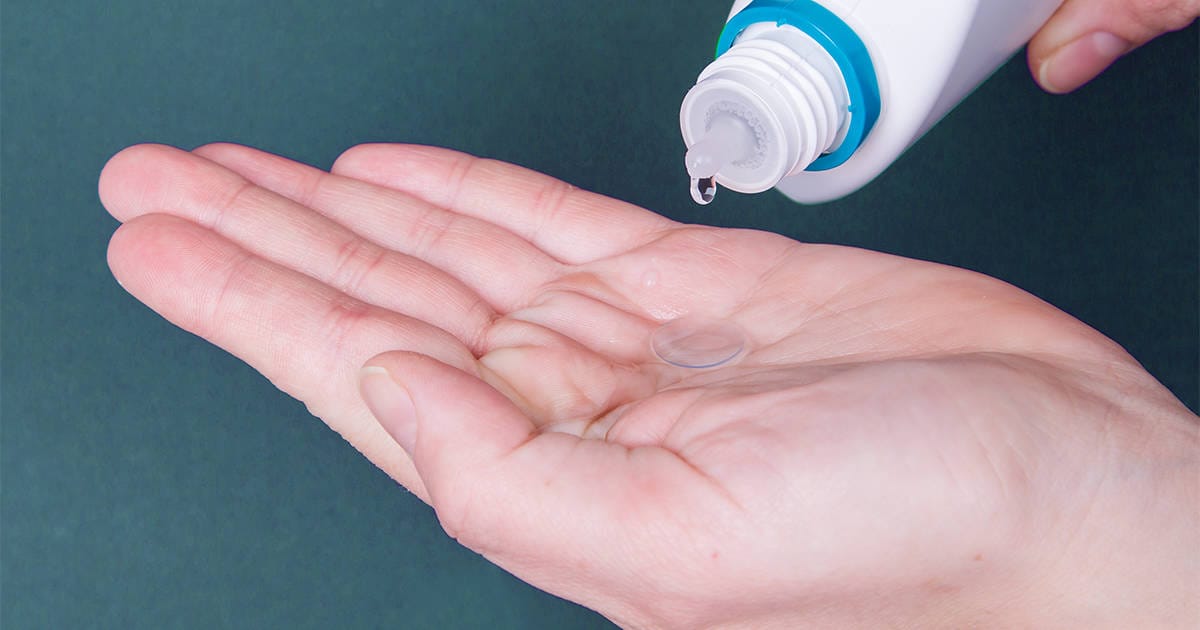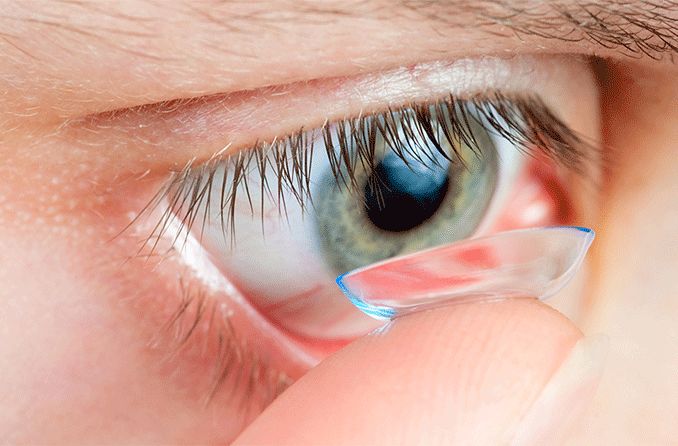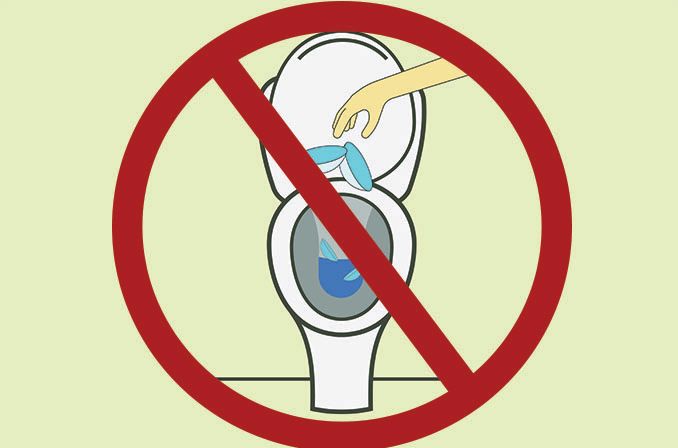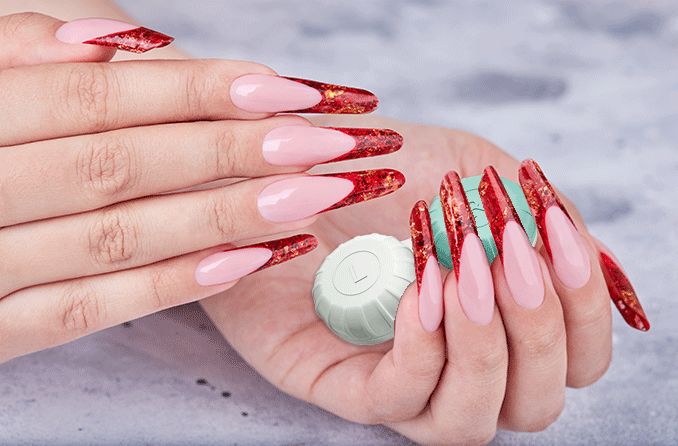Beginner’s guide to contact lenses
It takes time and practice to get the hang of wearing and caring for contact lenses.
Following contact lens recommendations can be frustrating. But once you’ve mastered the rules, it’s easy to see why millions of people have ditched their glasses in favor of contacts.
This beginner’s guide to contact lenses will give you a clear idea of what to expect.
The advice generally covers both soft and hard contact lenses as well as daily and extended-wear contacts. Care suggestions may vary based on which type of lenses you use.
How to put in contact lenses
Here are step-by-step instructions for how to put in contacts:

1. Before you do anything else, thoroughly wash your hands with soap and water; this decreases the chance of an eye infection. Avoid soaps that contain extra oils or fragrances, as they can stick to the surface of a lens.
2. Dry your hands with tissues or a lint-free cloth so that particles don’t float around in one or both of your eyes.

3. Remove one of the lenses from the storage case. Then, carefully slide it onto the tip of your index or middle finger on your dominant hand. Use your fingertips, rather than your nails, to handle the lens.
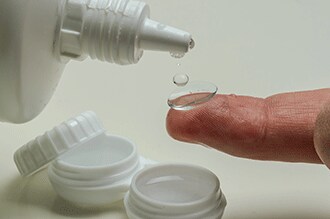
4. Rinse the lens with contact lens solution. If you drop a lens, rinse it with solution again before trying to put it in your eye.
5. Check for torn or damaged spots on the lens, and make sure it’s right-side out. If the lens forms a bowl and the edges turn up, you’re ready to put it on your eye. If the lens looks like a lid — the edges are turned out — reverse the lens.

6. Hold your upper eyelid open with your non-dominant hand while looking in the mirror. Pull down your lower eyelid with the middle or ring finger of your dominant hand.
7. Put the contact lens on your eye. Look in front of you or up at the ceiling while doing this.
8. Slowly shut your eyes and roll them in a full circle to help the lens settle properly. Open your eyes and gently blink a few times. Look in a mirror to see whether the lens shows up in the center of your eye.
9. If the lens is inserted and centered correctly, your eye should feel comfortable and your vision should be clear. If you feel discomfort or your vision is blurry, you’ll need to take out and reinsert the lens.
Once you’ve got the first lens in, repeat the process with the second lens.
SEE RELATED: How can I tell if my contact lenses are inside-out?
How to take out contact lenses

These are the steps for how to take out contacts:
- Handle the lenses only after you’ve carefully washed and dried your hands to prevent an eye infection.
- Flip over your storage case and shake out any leftover contact-lens solution, then air dry it or dry the case with a fresh, clean cloth.
- Stand in front of a mirror and look up. Pull down your lower eyelid with the middle finger of your dominant hand. Try to always remove the same lens first (right eye or left eye) to avoid confusion.
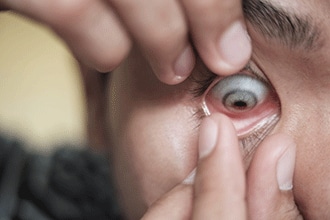
4. Carefully slide the contact lens down to the white of your eye with the index finger of your writing hand.
5. Gently pinch the lens with the pads of your index finger and thumb to remove it from your eye.
6. Repeat this process to remove the lens from your other eye.
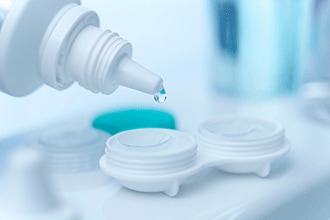
7. If your lenses are not daily disposables, clean them after removal. Follow the cleaning instructions provided by your eye care professional or the lens manufacturer. Use only recommended cleaning solutions; don’t use homemade solutions.
8. Put the contacts in a storage case and cover them with fresh contact solution. Throw away daily-wear lenses.
SEE RELATED: How to take out contacts with long nails
How to take care of your contacts and your eyes
Proper care of your contacts can help maintain healthy eyes and can prolong the life of your contacts. Experts recommend the following tips to caring for your contact lenses and protecting your eyes from infection:
- Clean the storage case for your contacts with warm soapy water at least once a week. Rinse it thoroughly and wipe it dry using a clean tissue.
- Replace the storage case at least every three months, or as recommended by your eye care professional.
- Remove your contacts if you’re experiencing unusual eye irritation. This may include redness, pain, discomfort, vision changes, light sensitivity, excessive tearing or strange eye discharge. Leave the contacts out until you see an eye care professional and get the problem resolved.
- Don’t wear contacts when you’re ill, even if it’s just a cold. When you’re sick, germs can spread from your hands to your eyes when you’re putting in or removing contacts.
- Remember to blink. Regular blinking helps keep your lenses clean and moist.
- Use rewetting drops as recommended by your eye doctor to prevent your eyes and contacts from drying out.
- Throw away contact lens solution one month after you’ve opened it, even if there’s some solution left.
- Never reuse contact lens solution.
- Don’t wear your contacts while sleeping unless your eye care professional says it’s OK.
- Avoid swimming or showering while wearing contacts unless, in the case of swimming, you’re wearing goggles. Exposing your eyes to water when your contacts are in can cause eye infections such as Acanthamoeba keratitis.
- Never clean or moisten contact lenses with saliva from your mouth. This can introduce germs to the contacts.
- Don’t use tap water to soak or rinse your lenses. This might lead to an eye infection.
Is my contact lens inside out?
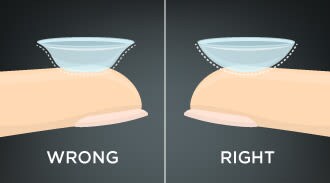
The difference between an inside out and a right-side out contact lens can be subtle. A good way to tell the difference is to ask yourself whether the lens looks like half of a ball, or a soup bowl with a rim.
The trick is to place the lens on your finger so that a cup is formed. Then hold the lens up directly in front of your eyes so you’re looking at the side of the cup.
If the edges of the lens flare out to create a “lip” along the edges, it’s inside out. If it forms just a perfect “U” shape, it’s in the correct position.
If you’re wearing lenses with a handling tint, another way is to place the lens on your fingertip and then look down at it. The edge of a tinted lens should look very blue (or green, depending on the tint); that won’t be the case if the lens is inverted.
Some contact lenses also have a laser marking, such as the brand name, on the edge to help you. If you can read it properly, the lens is not inside out.
Don’t worry if you place a contact lens in your eye inside out. The lens will feel uncomfortable, but it can’t do any damage.
SEE RELATED: How to read your contact lens prescription
Contact lenses and UV light
Researchers have linked ultraviolet (UV) light to the formation of cataracts. Exposure to excessive UV light also may result in a condition called photokeratitis, or “snow blindness.”
That’s why some contact lenses now contain a UV-blocking agent. You can’t tell if a contact lens has a UV blocker by looking at it — the blocking agent is clear, so as not to disturb vision. The contact lens packaging will specify if the product has a UV blocker, or you can ask your eye doctor.
Very important: UV-blocking contacts are not meant to replace sunglasses. A contact lens covers only your cornea, not your entire eye.
But, UV-blocking contact lenses help protect the covered parts of the eye from formation of growths such as pingueculae and pterygia.
Sunglasses with UV protection can cover more of your eye and the parts of your face that surround it. That’s why contacts with UV blockers are designed to complement sunglass use as an added protection.
Eye makeup and contact lenses
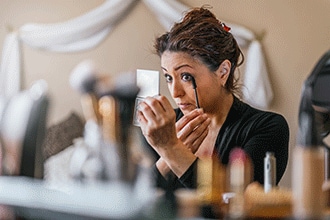
Getting makeup in your eye is annoying. But it’s even worse with contacts, because it can stick to the lenses instead of flushing right out. Follow these tips to keep your eyes looking and feeling good:
- Put your contact lenses on before applying makeup, always. It’s also important to wash your hands thoroughly before touching your contacts, so you won’t transfer any oils, creams or lotions to the lenses.
- Use only hypo-allergenic makeup. Lots of brands create eye makeup products for sensitive eyes that should cause little to no irritation.
- Cream eye shadow is less likely to get in your eye than powder. But creams can irritate your eyes more if they do make it into your eyes. Choose water-based creams rather than oil-based ones.
- Never apply eyeliner between your lashes and your eye — otherwise known as the “waterline.” Apply eyeliner only on the portion of your lashes that is well away from your eye.
- To remove eye makeup, wash and dry your hands. Then remove your contacts, being careful not to bump them into any makeup. Finally, use your eye makeup remover.
- Replace your eye makeup frequently — at least every three months. Bacteria can get into old eye makeup over time and potentially cause an eye infection. One way to tell if your makeup is too old is if it smells funny.
- Don’t share your eye makeup with others.
SEE RELATED: What happens if you get glitter makeup in your eye?
Fungal eye infections can occur even with proper contact lens care
Even if you follow your eye doctor’s recommendations for contact lens care, there’s still a chance for infection to develop.
Researchers investigated the presence of fungal contamination in study participants’ contact lens solution. All study participants were asymptomatic of infection and wore soft disposable contact lenses on a daily wear basis. The lenses were designed for monthly replacement.
After removing their contacts, the participants placed them inside their storage case. They then filled the case with a disinfecting solution recommended by their eye doctor.
The researchers took samples of the disinfecting solution in the cases and cultured them for four days.
Out of the 216 samples collected, 15 of them tested positive for at least one of several species of fungi capable of causing eye infections.
The study concluded that even when contact lens wearers are diligent with contact lens care, a risk of contact lens-related fungal eye infections is still present.
Tips for applying your contacts
To help make your transition into contact lens use a little smoother, here are some tips for when you’re applying your contact lenses:
- Stand over a clean, flat surface when handling your contacts. If you’re over a sink, be sure to plug the drain.
- Try to always put the first contact lens in the same eye, either the right or left. This keeps you from mixing up the right-eye and left-eye contacts, which may have different power or measurements.
- Avoid washing your hands with products containing lanolin and moisturizing lotions. These extra ingredients can get on the lenses.
- Gently shake your lens case with the storage solution beforehand. This can loosen the contact lenses if they are stuck. (Don’t try pulling at the lens with your finger, or you might tear it.)
Tips for removing your contacts
Removing contact lenses can be even trickier than putting them in. These tips may come in handy during the tricky process:
- Before you get to pinching, take a moment to look in the mirror and make sure you are actually wearing your contact lenses. Pinching the surface of your eye when a contact lens isn’t present can result in an injury to the cornea.
- Keep your fingernails short to prevent scratching your eyes or damaging your contacts while putting them in or taking them out.
- Carry an extra pair of glasses or contact lenses with you in case something happens to the contacts you’re wearing.
- Devices for removing contact lenses, called “plungers,” also are available from your eye doctor. They can be used to touch and remove a lens from your eye. Make sure you touch only the lens and not your eye’s surface with these devices.
You might hear a myth or two about someone “losing” a contact lens in the back of the eye. Rest assured, this is actually impossible. A membrane that connects your eye to the back of your eyelid blocks contacts from traveling back behind the eyeball.
Try using these tips and tricks the next time you apply, remove and care for your contact lenses. You’ll be a pro at it in no time!
For more contact lens tips, click the link for our printable handout on 5 Tips for Contact Lens Wearers.
